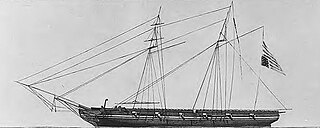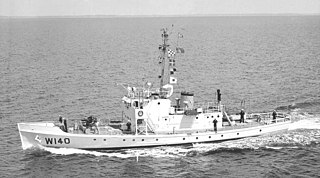
The United States Revenue Cutter Service was established by an act of Congress on 4 August 1790 as the Revenue-Marine upon the recommendation of Secretary of the Treasury Alexander Hamilton to serve as an armed customs enforcement service. As time passed, the service gradually gained missions either voluntarily or by legislation, including those of a military nature. It was generally referred to as the Revenue-Marine until 31 July 1894, when it was officially renamed the Revenue Cutter Service. The Revenue Cutter Service operated under the authority of the U.S. Department of the Treasury. On 28 January 1915, the service was merged by an act of Congress with the United States Life-Saving Service to form the United States Coast Guard.
Four ships of the Royal Navy have been named HMS Queen Charlotte after Charlotte, queen consort of King George III of the United Kingdom.

USS Bear was a dual steam-powered and sailing ship built with six-inch (15.2 cm)-thick sides which had a long life in various cold-water and ice-filled environments. She was a forerunner of modern icebreakers and had a diverse service life. According to the United States Coast Guard official website, Bear is described as "probably the most famous ship in the history of the Coast Guard."
USS Gallatin was a post-Revolutionary War sailing vessel that the U.S. Department of the Treasury purchased at Norfolk, Virginia, for the United States Revenue-Marine in December 1807. An explosion on board destroyed her in 1813.
USRC Active was the name of six vessels of the United States Revenue Cutter Service, and may refer to:
USRC Active, was a revenue cutter of the United States Revenue Cutter Service in commission from 1812 to 1817. She was the second Revenue Cutter Service ship to bear the name.

HMS Tigress was the American merchantman Numa and then French letter of marque Pierre Cézar that the Royal Navy acquired by capture and put into service as the gunbrig Tigress. She spent some time on the West African coast in the suppression of the Triangular slave trade. The Admiralty later renamed her as Algerine. She was broken up in 1818.
Several vessels of the Royal Navy have been named HMS Nimble.
HMS Brazen was a 28-gun Royal Navy Bittern-class ship sloop, launched in 1808.

African Slave Trade Patrol was part of the Blockade of Africa suppressing the Atlantic slave trade between 1819 and the beginning of the American Civil War in 1861. Due to the abolitionist movement in the United States, a squadron of U.S. Navy warships and Cutters were assigned to catch slave traders in and around Africa. In 42 years about 100 suspected slave ships were captured.

The West Indies Anti-Piracy Operations were a series of military operations and engagements undertaken by the United States Navy against pirates in and around the Antilles. Between 1814 and 1825, the American West Indies Squadron hunted pirates on both sea and land, primarily around Cuba and Puerto Rico. After the capture of Roberto Cofresi in 1825, acts of piracy became rare, and the operation was considered a success, although limited occurrences went on until slightly after the start of the 20th century.
HMS Speedwell was the mercantile Royal George, which the Royal Navy purchased in 1815 and converted to a 5-gun schooner. During her career in the West Indies, she helped capture or destroy a number of pirate vessels, and capture several slave ships transporting enslaved people. The Royal Navy sold her at Jamaica in 1834.

USCGC Crawford (WSC-134), was a 125 ft (38 m) United States Coast Guard Active-class patrol boat in commission from 1927 to 1947. She was named for William H. Crawford, (1772–1834) who was appointed in 1816 as Secretary of the Treasury by President James Madison and he continued under President James Monroe through 1825. Crawford was the seventh vessel commissioned by the U.S. Revenue Cutter Service and the Coast Guard named after the former secretary. She served during the Rum Patrol and World War II performing defense, law enforcement, ice patrol, and search and rescue missions.

HMS Thais was built for the British Royal Navy in 1806 and was the name-vessel of her class of fire ships. Between 1811 and 1813 she served in the West Africa Squadron, which was attempting to suppress the slave trade. During this service she captured several slave traders and an American privateer. She made one voyage to the East Indies. Thais was sold in 1818. She then became a merchantman. She was last listed in 1826.
Several ships have been named Swallow for the bird Swallow:
Several vessels have been named Westmoreland:
HMS Lion was the pirate schooner Gata, built in Baltimore in 1820, that the Royal Navy captured in 1823 and took into service. She took part in numerous expeditions against pirates, recaptured some of their prizes, and captured a slave ship. The Navy sold her in 1826.
USRC Detector was a Wasp-class schooner built for and operated by the United States Revenue Cutter Service from 1825 to 1832. She is the second ship of the Revenue Cutter Service to bear the name.






